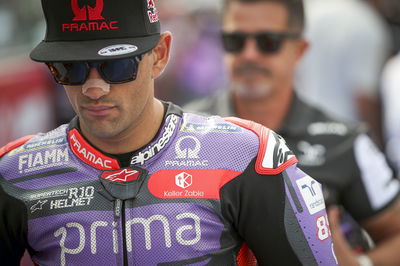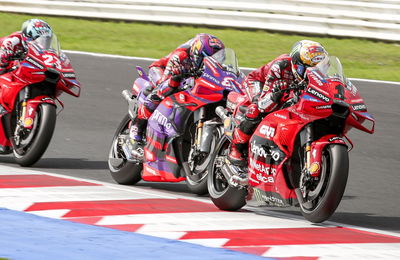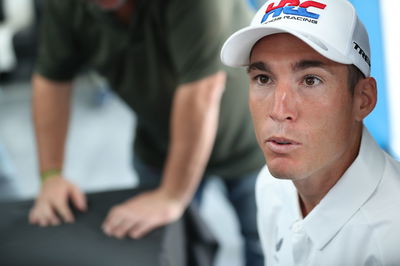Awkward questions raised by stewards’ non-call over Enea Bastianini-Jorge Martin
Is a new precedent for the rules of engagement now set?

Good hard racing? On the limit but fair? Too aggressive and warranted a penalty?
Rather unsurprisingly, the last lap moment between Jorge Martin and Enea Bastianini that decided the outcome of the 2024 Emilia Romagna Grand Prix has dominated conversation since the chequered flag was waved on MotoGP’s 14th round of the season.
Even less surprising is the lack of unanimity on how it was handled.
Bastianini saw a gap into Turn 4 and launched his factory Ducati up the inside. Martin was beginning to turn as the Italian drew alongside, but there was a slight bit of contact. Martin came off the worst as he was forced to the fringes of the gravel trap on the outside of the corner, while Bastianini went on to claim a second win of the season by a shade over five seconds.
Martin was furious as he crossed the finish line, sending a ‘f*** you’ gesture in the direction of a celebrating Bastianini ahead of him. Once cooled off, however, Martin regretted his gesture.
Bastianini’s win has put him into third in the standings, 59 points behind Martin heading to this weekend’s Indonesian GP.
Enea Bastianini gave Ducati their 100th premier class win 🏆🇮🇹 They sit 4th all-time 📊#MotoGP pic.twitter.com/0TLKz93SnJ
— Crash MotoGP (@crash_motogp) September 22, 2024
The blame game
When it came time to speak to the media, both Martin and Bastianini held differing views on the incident.
“I think there was no room to make that move,” Martin argued. “There is not a lot of sense to keep talking about it because it won’t change anything. But for sure I think I deserved that victory. At least if he made a move, at least do it clean and don’t touch me.”
Bastianini countered: “Yes, it was a bit on the limit but in the end it was the only choice because without this possibility it was impossible for me because on the rest of the track [Martin] was super nice and was the only possibility for me.”
In any incident, you’re never very likely to find two riders who agree with each other. Bastianini wasn’t punished, so therefore he will feel like he did nothing wrong. Martin was on the receiving end of it, so of course his view will be opposing.
When the shoe was on the other foot in Qatar last year - as world champion Francesco Bagnaia nodded to when asked for his opinion - Martin, who made an aggressive move on Bagnaia in the sprint at Turn 6 which resulted in contact, felt he was within the limits of what was acceptable.
Ironically, when Bagnaia at the time was pressed for his thoughts on that, he said: “I think it’s cool it was him who was doing that, so it’s opening a situation that I like.”
What Bagnaia meant by that comment was that it redefined the rules of engagement and aggressive, ‘rubbin-is-racin’ was on the table in their title battle.
That Qatar moment, incidentally, was not looked at by the stewards. And neither was last Sunday’s last lap clash between Bastianini and Martin. As far as Martin is concerned: “For sure, now I think we are more clear about race direction’s ideas for the future. So, in the future if I have to do the same, then no consequences… I hope.”
Did the stewards make the right call?
This is the big question, and one that doesn’t seem to have a right answer.
Arguably, the decision on this has to be split into two factors: was it good for the show, and was it handled correctly?
Let’s tackle the first part.
There is no denying that Bastianini’s move was daring and he was rewarded for it by coming away with the lead. It was the culmination of a tense grand prix at the front in which Martin couldn’t get his gap to Bastianini above much more than 0.8s for most of it.
Bastianini had been able to study Martin’s advantage for all the time he was sat behind him, and he determined that Turn 4 was his only chance. Martin was too strong in the second half of the lap and Bastianini wouldn’t have been able to do anything in those final big braking zones at Turn 14 and Turn 16.
He saw his gap, he went for it, he made the move work and that was that. It was aggressive and it did force Martin off track. MotoGP has often relaxed its rules in last lap battles, because - much like race starts - the lines of acceptability are slightly skewed.
Bastianini not being stripped of a win was good for the show, it was good for the Italian fans at Misano and it was good for the fans watching at home, who didn’t turn off the TV to then find out later that what they saw actually didn’t matter.
There is an argument to be made that the fact a factory Ducati team rider beating Martin after Bagnaia had crashed out has a big bearing on the championship picture - with 24 points instead of 29 splitting Martin and Bagnaia - and that is not something the stewards panel wants to get involved in.
That isn’t a totally unheard of approach, either. In the National Hockey League in North America, referees aren’t as stringent with penalty calls - especially in sudden-death overtime situations - during the playoffs in order to not have an overarching influence on results. This largely applies to calls that aren’t especially clear cut.
But, that often then means a blind eye is turned to incidents that deserve punishment and the trust in stewardship erodes anyway.
When it comes specifically to to the Martin/Bastianini incident, it’s not clear cut. There was a gap for Bastianini to try a move, albeit a risky one and there was contact. Martin ends up off track, but so does Bastianini - though not to the same extent. What makes this one harder to call is the fact that Bastianini ends up on the blue paint beyond the kerb because he looks left towards Martin.
So, it’s really hard to accurately judge whether or not Bastianini was always going to make the corner or was heading wide regardless.
The FIM’s rule book, under Article 1.21.2 states: “Riders must ride in a responsible manner which does not cause danger to other competitors or participants or gain an unfair advantage, either on the track or in the pitlane. Any infringement of this rule may be penalised by the FIM MotoGP Stewards.”
The wording of this rule is too ambiguous to cover the rules of engagement in MotoGP. As far as “gain an unfair advantage”, Bastianini’s overtake was made easier by the fact contact resulted in Martin running off track. But surely also any riding that results in contact can be considered to “cause danger”? Or is it only dangerous if a move results in a crash?
This type of thing is discussed in safety commission meetings with the riders, but there is an overall lack of transparency publicly when it comes to how the stewards reach the decisions they do.
After Sunday’s grand prix at Misano, the stewards panel issued its usual end-of-day document containing all incidents it oversaw. The Martin/Bastianini overtake was not on there. The stewards had a perfect opportunity to offer some clarity on why it didn’t even elect to investigate the incident - and given the wording of its own rules, there surely should have been one.
That’s not exactly new, either, but in such a public incident that then reverberated through the paddock, why the stewards didn’t see fit to provide transparency and explain its decision is baffling. And it once again raises questions about the effectiveness of the current stewarding process in MotoGP.
Is this an issue of MotoGP’s own making?
The rest of the grid were split over it. The likes of Aleix Espargaro, Luca Marini and Marc Marquez felt the move crossed a line and the lack of penalty wasn’t the right call. Marquez’s reasoning was that Bastianini didn’t stay on track either, and therefore the move was over the line and he should have been demoted a position.
Espargaro, it’s worth noting, took aim at the stewarding process at the French GP after he was on the receiving end of two harsh overtakes - one involving Bastianini, ironically - that forced him off track. Neither was investigated.
Jack Miller, on the other hand, fell into the pro-Bastianini camp. A hard racer himself and champion of MotoGP’s show, Miller felt it was a case of last lap and all bets off. He was punted wide by Johann Zarco on the last lap of the Emilia Romagna GP which dropped him out of the points.
That incident wasn’t investigated either, though it probably should have been too.
In terms of consistency, the Bastianini/Martin outcome has been seen at other races this year. The second Espargaro clash at the French GP happened on the last lap and saw him lose positions as a result of being nudged off track. After that, the Aprilia rider reasoned that stewards will only take action if an action results in a crash.
However, Johann Zarco was - as per the stewards panel note - going to be asked to drop one place to Acosta after nudging him wide while overtaking him at Turn 5 on lap one of the Spanish GP. Because Zarco rectified this himself, no penalty was handed out. Acosta, it’s worth noting, wasn’t forced off track. The stewards, though, haven’t explained why they felt that contravened the rules but Misano didn’t.
Inconsistency has been a constant frustration with the current stewards panel helmed by double 500cc world champion Freddie Spencer. So much so that Zarco blew up in the stewards room after a collision with Aleix Espargaro at Jerez - which was deemed a racing incident.
And there have been other bizarre calls in recent times, like Takaaki Nakagami escaping punishment for wiping several riders out at Turn 1 of the 2022 Catalan GP, or Bagnaia being forced to cede a place to Miller at Jerez last year for a tough-but-fair overtake that resulted in no contact and no disadvantage for the Australian.
Perhaps, then, the question does have to be raised (circling back to my earlier NHL reference): are the stewards now being deliberately relaxed from a fear of backlash?
One important element of the Bastianini/Martin incident does have to be considered, and it’s one several riders made note of.
Racing in MotoGP, with the current front tyre, massive amounts of aero load and ride height device, is infinitely harder to do. At the San Marino GP, Bagnaia noted that he couldn’t do anything to pass Martin in the sprint because of the turbulent air and heat coming from his bike. And again in the Emilia Romagna GP weekend, overtaking was at a premium.
The more aggressive overtakes we see now are a direct result of the riders having fewer opportunities to actually make a pass.
“For me, I agree with the overtake,” Marc Marquez said of Bastianini’s move. “It’s the only way to overtake with these bikes.”
Very much, the Bastianini/Martin incident is a case of ‘get used to it’. But, arguably, that should then mean a greater need for more stringent policing from the stewards.
Has the Misano verdict set a new precedent?
Martin certainly believes the stewards have shown what is now acceptable as far as the rules of engagement go. But, in reality, the precedent was set years ago.
Now, MotoGP hasn’t exactly been a demolition derby over the years. But flick through the history book and you’ll find plenty of example of over-the-limit, last lap overtakes that never went unpunished. And are, in fact, celebrated.
Pedro Acosta told the media at Misano last Sunday that “all the great riders have made overtakes like this”, in reference to Bastianini’s race-winning move.
Perhaps the most famous example of this is Valentino Rossi versus Sete Gibernau for victory at the last corner of the 2005 Spanish Grand Prix. There’s not really any escaping the fact that move should have been punished. But it wasn’t and it stands as one of MotoGP’s most memorable moments (rightly so, too).
But a few years ago, Gibernau told TNT Sport that it set the tone for the way racing has been since.
“To tell you the truth, no. I don’t think so,” he said at the time when asked if he thought the stewards today would have looked into Jerez 2005, while also noting: “I don’t know how many times we’ve talked about that corner, but the more time goes by the more I understand after that, things change.
“Many people were seeing that move, and from that moment on it opened the door for it to happen many more times. At the end of the race, both of us did what we thought was best for the championship, and my opinion can be whatever. But since then things have changed in MotoGP and racing is understood, which I don’t agree [with].”
Gibernau, like Martin at Misano last weekend, was on the receiving end. So his opinion, like Martin’s, is partly shaped by that. That is the nature of racers: everything is fine until it happens to them.
But the general response to the Bastianini move suggests the willingness to accept it as the tolerable limit has long settled into what we think racing should be.
Whether the stewards were right not to investigate Bastianini really doesn’t matter, especially against its refusal to provide any explanation on how it reached that decision. But that does now offer up the worrying possibility that they will have to stick by it through any similar incidents going forward regardless of the consequences…












